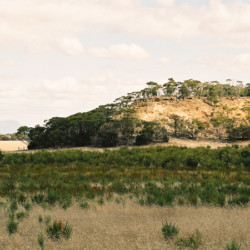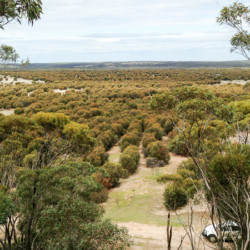Most of Nowanup’s 350 ha of previously cleared paddocks have been replanted. A range of restoration techniques have been used and have informed future restoration practices. The restoration includes some trials of local species with commercial potential and more recently some culturally led plantings including the 6 seasonal circles.
Greening Australia’s 754 ha Nowanup property was one of the first purchased with donor funds to help achieve Gondwana Link’s goal of reconnecting native habitats across south-western Australia. Nowanup sits almost midway between the Stirling Range and Fitzgerald River national parks and the ecological restoration of this property has filled a significant habitat gap between the Corackerup Nature Reserve and the crown lands along the Corackerup Creek. An example of the value of the restoration is that Tammar wallabies, once common in the region but now rarely found, are now free to move through Nowanup to the neighbouring bushland. The tammars expanded range will likely have positive effects on gene flow and population dynamics.
Restoration of the property began as soon as the stock was removed in 2004. In a number of areas the native seed stored in the soil germinated and the resulting plant communities thrived. This included areas of natural grasslands. However larger areas needed to be manually restored. Some of the earlier plantings reflected a low-diversity revegetation approach. In addition early restoration success was impacted by difficulties in achieving good germination of a number of species on the sites difficult clay soils, with the result that many areas are dominated by a few species of eucalypts and acacias. These areas have since been enriched through in-fill plantings.
Over subsequent years the standard of the restoration work across Gondwana Link has vastly improved to better reflect the goal of ecological restoration modelled on local reference sites (see Monjebup summary). This has included improvements in the direct seeding techniques and resulted in Greening Australia using direct drilling instead of scalping in 2014, a technique that has subsequently been widely adopted.
An area was planted with a local melaleuca, Melaleuca uncinatum, as a trail for broombush fencing. This resource has been perfect for the building of the Meeting Place and the cultural mia mia’s on the property. It has also been distilled and the oil, with it’s useful properties, incorporated into creams and other products.
In 2005 mallet pole trial to explore the silvicultural requirements of mallet eucalypts to produce a pole product for vernacular architecture. Although the poles were strong the white ants loved them. But nothing ventured- nothing gained. Areas have also been seeded with sandalwood nuts once the host plants had been established.
Suitable areas were planted with Corackerup moort Eucalyptus vesiculosa, and common moort E. platypus subsp. Platypus. E. vesiculosa, which has red flowers, has an extremely limited range and occurs in only a few pockets in the region so these plantings consolidated the species presence.
The most recent restoration has been cultural plantings. In 2015, integration of cultural and ecological aspects was advanced through a 2015 direct seeding project collaboratively designed and implemented by Eugene Eades and restoration practitioner Justin Jonson. The six seasonal circles planting integrates indigenous cultural meaning and values into an ecological restoration project. This site is now used in cultural exchange events and camps.
Both the original habitat areas and the revegetation and restoration areas of Nowanup are under protective covenant.
The restoration at Nowanup has been undertaken by Greening Australia and has involved a range of other advisors and practitioners.
Revegetation costs were largely met through the Reconnections program, funded by Shell Australia, the Commonwealth Government’s Biodiversity Fund and 20 Million Trees Programme.














